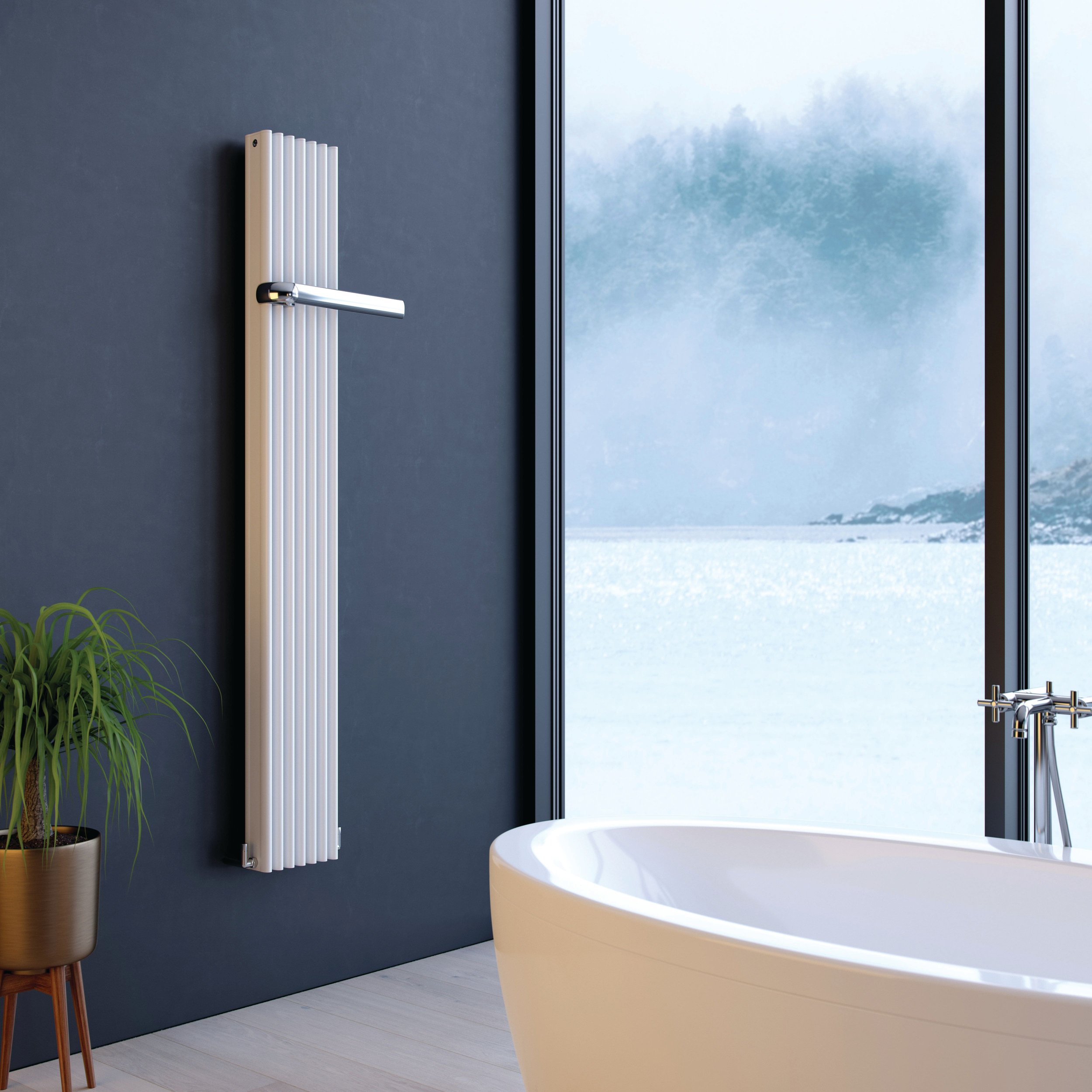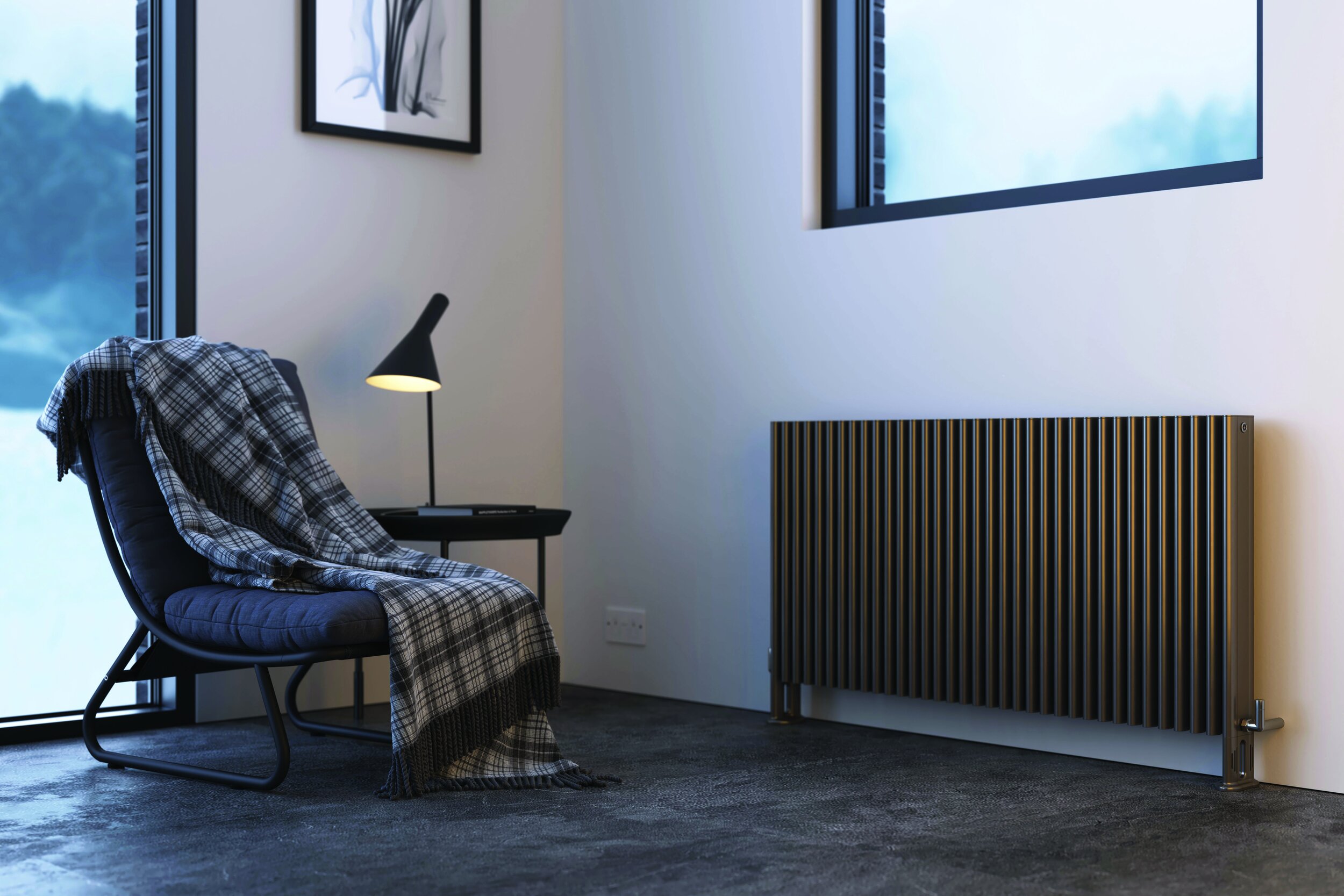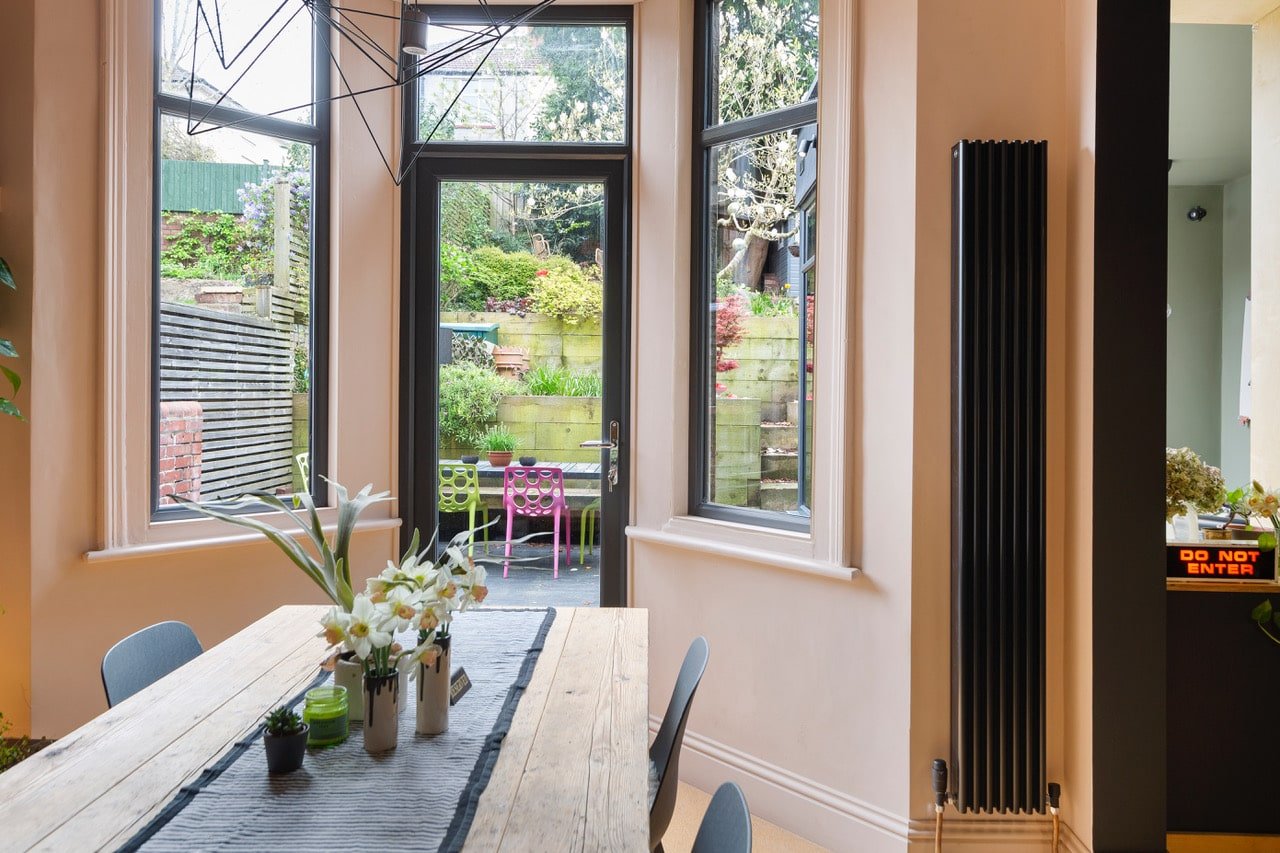Best radiator for heat pump
In recent years, there has been a lot of buzz about a new and exciting technology - heat pumps. In the initial days when I read about them, I did not pay much attention, but it was hard to ignore them when I heard that the UK government was promoting grants linked to Heat pumps.
So, in today’s blog, let’s talk about Heat pumps.
From saving money on energy bills to reducing carbon emissions, the benefits of heat pumps have captured the attention of homeowners and policymakers alike. In this blog, we will explore how the government is promoting the use of heat pumps and offering financial aid to encourage a more sustainable future.
But how do Heat Pumps work?
It is always great to understand the basics before we get excited about a new piece of technology. So let us explain.
Have you ever felt how warm your house is when you stand close to the refrigerator? That's because a refrigerator works like a small heat pump!
A heat pump is a machine that can take heat from one place and move it to another place. Just like how your refrigerator takes heat from inside and moves it outside to keep the food cold.
Heat pumps can also be used to make a house warm. They take heat from outside, even when it's cold, and move it inside to make the house warm and cosy.
The way a heat pump works is by using a refrigerant to absorb heat from the air outside your home. This refrigerant is then compressed, which raises its temperature, and it releases heat inside your home.
In the summer, this process is reversed. The heat pump absorbs heat from the air inside your home and releases it outside. This is why heat pumps are often used as air conditioning units.
What's really neat about heat pumps is that they don't create heat; they just move it from one place to another. This makes them much more energy-efficient than traditional heating and cooling systems, like furnaces or air conditioners, which have to create heat or cool air from scratch.
Heat pumps work especially well in moderate climates, where the temperature doesn't fluctuate too dramatically. They can be a great way to save energy and money on your heating and cooling bills, while also reducing your carbon footprint.
So, in a nutshell, heat pumps work by moving heat from one place to another using a refrigerant. They're more energy-efficient than traditional heating and cooling systems and are great for moderate climates.
What kind of radiator is the best for heat pumps?
When it comes to choosing a radiator for your heat pump, there are a few things to keep in mind.
Firstly, it's important to choose a radiator that is compatible with your heat pump's output. This means you'll need to consider the heat output of your heat pump and match it with the appropriate radiator size. If the radiator is too small, it won't be able to efficiently distribute heat around your home, and if it's too big, it will waste energy and be more expensive to run.
Secondly, it's worth considering the material of the radiator. Radiators can be made from a range of materials, including cast iron, steel, and aluminium. Aluminium radiators are a popular choice for heat pumps, as they're lightweight and have good heat transfer properties. They're also resistant to corrosion, which can be a problem in some heating systems.
Another factor to consider is the style of the radiator. Radiators come in a range of shapes and sizes, from traditional column radiators to modern panel radiators. You'll want to choose a style that suits your home's aesthetic and matches your personal preferences.
Lastly, it's worth considering the location of the radiator. Ideally, you'll want to place the radiator in a location that allows for optimal heat distribution around your home. This might mean placing it under a window, for example, where it can counteract any cold air coming in from outside.
In summary, when choosing a radiator for your heat pump, it's important to consider the size, material, style, and location of the radiator. By taking these factors into account, you can ensure you choose a radiator that's both efficient and aesthetically pleasing.
Right Material Matters
When it comes to selecting radiators for heat pump systems, it's essential to consider factors such as thermal conductivity, design efficiency, energy consumption, and overall cost-effectiveness. What your radiator is built with, could act as a backbone of your radiator’s efficiency. Further in this blog, we will delve into the advantages of aluminium radiators over their steel counterparts, demonstrating why aluminium radiators are the superior choice for heat pump installations. From their exceptional thermal conductivity to compact design and energy efficiency, we will explore how aluminium radiators optimize heating performance while offering cost savings.
Unmatched Thermal Conductivity: Aluminium radiators possess thermal conductivity more than 5 times greater than that of steel. This means that aluminium efficiently conducts heat over longer distances compared to steel radiators. For instance, when designing multicolumn radiators, aluminium's superior conductivity enables the placement of hollow heated surfaces at a considerable distance from the central water gallery. In contrast, steel radiators require direct contact between the outer surface and the hot water inside the radiator. This property is especially advantageous when working with low water temperatures, as it allows for the creation of compact radiators with intelligent configurations, effectively maximizing surface area for heat dissipation.
Compact Design and Efficient Heat Dissipation: The ability to incorporate significantly more surface area into a given space is a major benefit of aluminium radiators. With compact radiators, less wall space is occupied, and in many cases, only a single radiator is required, eliminating the need for multiple units. Conversely, standard steel radiators necessitate larger sizes to dissipate the same amount of heat. As a result, aluminium radiators offer efficient heating solutions while optimizing room layouts and aesthetics.
Low Water Volume and Energy Efficiency: Compared to comparable steel radiators, aluminium radiators utilize only about a quarter of the water volume. This reduction offers several advantages. Firstly, it requires significantly less energy to raise the radiator's temperature to its operating level. Aluminium radiators can achieve operating temperature using just a third of the energy required by steel multicolumn radiators. Moreover, when optimized for heat pump temperatures, such as the Octopus system, aluminium radiators demonstrate even greater energy efficiency. The low weight and water volume of aluminium radiators translates to faster heating and cooling times, making them highly responsive to temperature adjustments.
Enhanced Comfort and Cost Savings: Unlike heavy steel radiators, aluminium radiators are quick to heat up and cool down. Heavy radiators with high water volumes tend to retain heat for extended periods, leading to discomfort in the event of overheating. Occupants often resort to opening windows to regulate temperature, resulting in wasted energy, increased carbon emissions, and higher running costs. By choosing aluminium radiators, you can avoid these issues and enjoy a more comfortable living or working environment. Furthermore, aluminium radiators offer cost savings in several areas, including lower energy consumption, reduced delivery and installation costs (as they can be handled by a single installer), elimination of the need for wall reinforcement, and optimal utilization of living space.
Eskimo Aluminium Column Radiators
When searching for the best-performing radiator to use with your heat pump, look no further than the Eskimo Column radiator.
Designed and developed in the UK with heat pumps in mind, the Column is made entirely of lightweight aluminium, which makes it both durable and energy-efficient. With exceptional heat output compared to other competitors, it's no wonder that the Eskimo Column has sold over 20,000 units in just a few years! And with a 5-star rating on Trustpilot, it's clear that customers love this radiator's designer looks and exceptional performance.
Available in both horizontal and vertical variants, Eskimo columns come in a multitude of sizes to get along with your creative vision of interior decor. Unlike steel radiators, Eskimo aluminium Column radiators are highly resistant to corrosion. This means that they're less likely to rust or deteriorate over time, which can extend the lifespan of the radiator and save you money on repairs or replacements.
Here is what our customers are saying about Eskimo Column radiators -


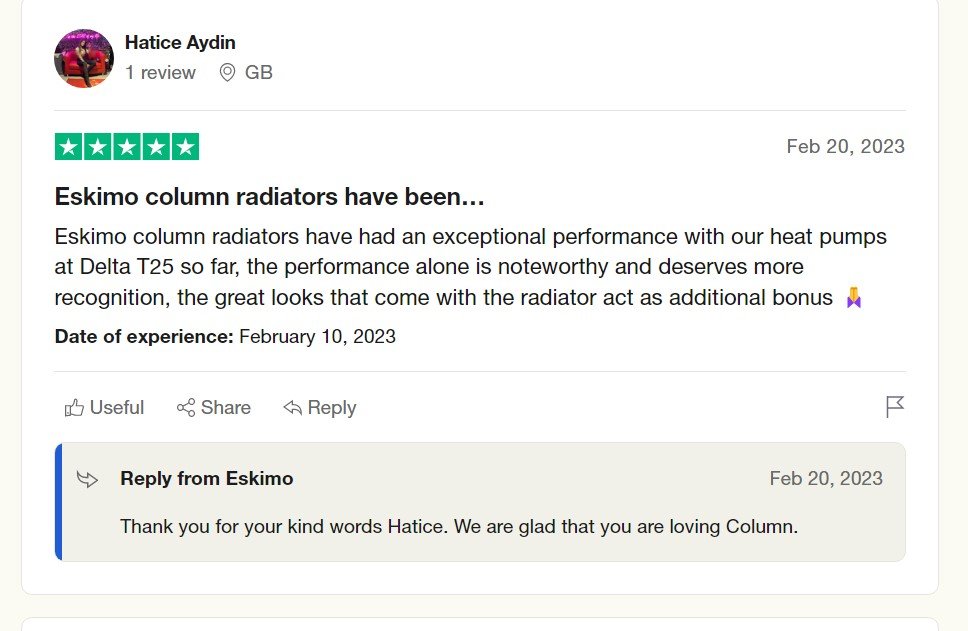
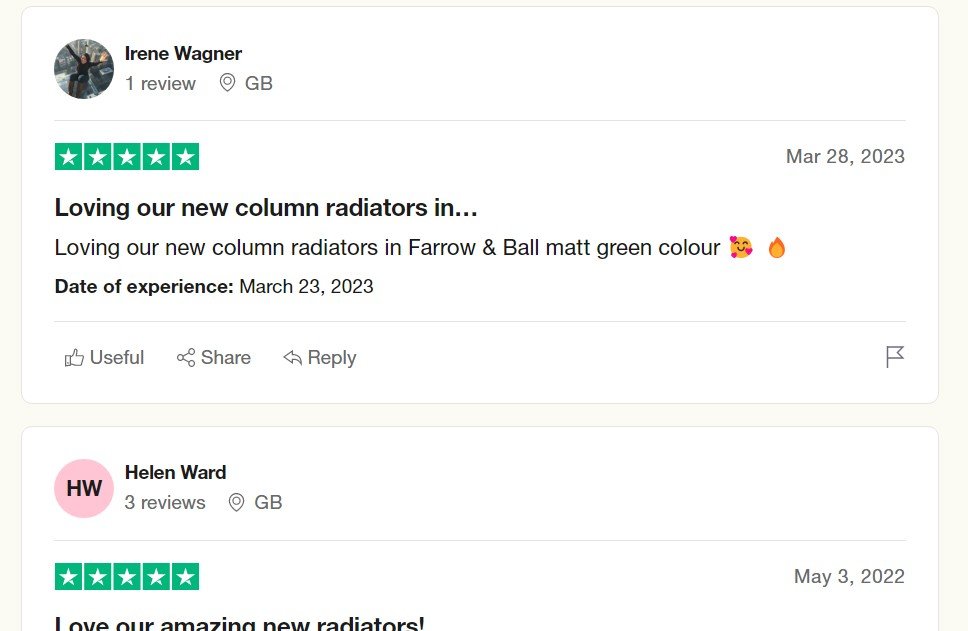
Why Aluminium Columns are better than steel columns?
Lightweight: Aluminum radiators are generally much lighter than their steel counterparts. This means that they're easier to move around and install, which can be a big advantage if you need to make adjustments or changes to your heating system.
Corrosion-resistant: Unlike steel radiators, aluminium radiators are highly resistant to corrosion. This means that they're less likely to rust or deteriorate over time, which can extend the lifespan of the radiator and save you money on repairs or replacements.
Energy-efficient: Aluminum radiators are highly energy-efficient, which means that they can help to reduce your energy bills and carbon footprint. This is because aluminium has better heat transfer properties than other materials, which allows it to heat up more quickly and efficiently.
Quick to heat up: Another advantage of aluminium radiators is that they heat up quickly. This means that you don't have to wait long for your home to warm up, which can be especially important if you have young children who need to stay warm and comfortable.
Safe: Finally, aluminium radiators are generally considered to be safe for children. They don't get as hot as some other types of radiators, which can reduce the risk of burns or injuries. Plus, aluminium is a non-toxic material, so you don't have to worry about any harmful chemicals or substances being released into the air.
Are we sure? You may have heard steel radiators are better for the heat pumps?
Whenever questioned with opinions, we always prefer reaching out to science for our answers as a company. As per the scientific data, the figure for the thermal conductivity of aluminium is – 247 W/m•K. Whereas, the thermal conductivity of steel is measured at approximately 45 W/(mK), which is extremely low compared to copper and aluminium which exhibit a thermal conductivity value of 398 W/(mK) and 235 W/(mK) respectively.
Furthermore, a study published in the Journal of Thermodynamics and Heat Transfer found that aluminium heat exchangers had a higher overall heat transfer coefficient than steel heat exchangers under the same operating conditions. The study noted that this was likely due to the higher thermal conductivity and lower density of aluminium, which allowed for more efficient heat transfer.
How to decide what size of radiator is required in our home?
When deciding on the size of the radiator required for your home, there are several factors that you should consider. Here are some tips to help you make an informed decision:
Room size: The size of the room where the radiator will be installed is the most important factor to consider. A larger room will require a larger radiator to effectively heat the space.
Insulation: The level of insulation in your home will also play a role in determining the size of the radiator required. A well-insulated home will require a smaller radiator than a poorly insulated one.
The number of windows and doors: Rooms with more windows and doors will require a larger radiator as heat is lost through these openings.
Heat output: Consider the heat output of the radiator, which is measured in watts or BTUs (British Thermal Units). The higher the heat output, the more heat the radiator will produce.
You can use our Heat Loss Calculator to get an estimate of the heat output required for your rooms.
Once you have figured out your output requirements, you can use our Column Heat Pump selector to pick up the best size as per your requirements.




